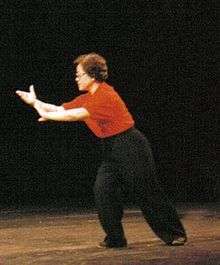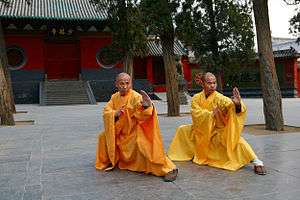Wu-style t'ai chi ch'uan
 Wu Yanxia in the posture Grasp Bird's Tail during a form demonstration in Toronto, 1995 | |
| Also known as |
Wu-style taijiquan Wu family taijiquan Wu school of taijiquan Wu-shi taijiquan Ng Style Tai Chi |
|---|---|
| Date founded | late 19th century |
| Country of origin | China |
| Founder | Wu Jianquan |
| Current head |
Wu Guangyu 5th gen. Wu |
| Arts taught | T'ai chi ch'uan |
| Ancestor arts | Yang-style taijiquan |
| Practitioners |
Wu Quanyou, Wu Gongyi, Ma Yueh-liang (馬岳樑), Wu Yanxia |
| Official website |
WuStyle |
| Part of a series on |
| Chinese martial arts (Wushu) |
|---|
 |
|
Styles of Chinese martial arts
|
| Wushu in the world |
|
Historical locations Chen Village (陳家溝) |
| Wushu athletes/practitioners |
|
Legendary figures Bodhidharma (菩提達摩) |
|
Historical individuals Yue Fei (岳飛; 1103—1142) |
|
Modern celebrities Bruce Lee (李小龍 1940—1973) |
| Wushu influence |
|
Related |
The Wu family style (Chinese: 吳家 or 吳氏; pinyin: wújiā or wúshì) t'ai chi ch'uan (Taijiquan) of Wu Quanyou and Wu Chien-ch'uan (Wu Jianquan) is the second most popular form of t'ai chi ch'uan in the world today, after the Yang style,[1] and fourth in terms of family seniority.[2] This style is different from the Wu style of t'ai chi ch'uan (武氏) founded by Wu Yu-hsiang. While the names are distinct in pronunciation (Chinese: 武氏; pinyin: wǔshì) and the Chinese characters used to write them are different, they are often romanized the same way.
History
Wu Quanyou was a military officer cadet of Manchu ancestry in the Yellow Banner camp (see Qing Dynasty Military) in the Forbidden City, Beijing and also a hereditary officer of the Imperial Guards Brigade.[3] At that time, Yang Lu-ch'an was the martial arts instructor in the Imperial Guards, teaching t'ai chi ch'uan, and in 1850 Wu Ch'uan-yu became one of his students.[2]
In 1870, Wu Ch'uan-yu was asked to become the senior disciple of Yang Pan-hou, Yang Lu-ch'an's oldest adult son, and an instructor as well to the Manchu military.[1][2] Wu Ch'uan-yu had three primary disciples: his son Wu Chien-ch'uan, Wang Mao Zhai and Guo Fen.[4]
Wu Ch'uan-yu's son, Wu Chien-ch'uan, and grandchildren: grandsons Wu Kung-i and Wu Kung-tsao as well as granddaughter Wu Ying-hua were well known teachers.[3]
Wu Chien-ch'uan became the most widely known teacher in his family, and is therefore considered the co-founder of the Wu style by his family and their students.[5] He taught large numbers of people and his refinements to the art more clearly distinguish Wu style from Yang style training.[5]
Wu Chien-ch'uan moved his family south from Beijing (where an important school founded by other students of his father is headquartered, popularly known as the Northern Wu style) to Shanghai in 1928, where he founded the Chien-ch'uan T'ai Chi Ch'uan Association (鑑泉太極拳社) in 1935.[3]
Wu Kung-i then moved the family headquarters to Hong Kong in 1948.
His younger sister Wu Ying-hua and her husband, Ma Yueh-liang (Ma Yueliang, 馬岳樑, 1901-1999), stayed behind to manage the original Shanghai school.[6]
Between 1983 and her death in 1996 Wu Ying-hua was the highest-ranked instructor in the Wu family system. Her descendants continue teaching and today manage the Shanghai school as well as schools in Europe:
- Ma Hai Long is the current head of the Shanghai Jianquan Taijiquan Association.
- Ma Jiang Bao lives in the Netherlands and teaches traditional taijiquan throughout Europe.
- Her granddaughter Dr Jin Ye lives and teaches in England.
- Her adopted daughter Shi Mei Lin now lives and teaches Wu-style taijiquan in New Zealand, with students also in France and The United States.
Wu Kung-i's children were also full-time martial art teachers:
- His son Wu Ta-k'uei was active in the resistance to the Japanese invasion of China, yet he later taught t'ai chi ch'uan in Japan after the war.[1]
- His younger brother, Wu Ta-ch'i, supervised the family's Hong Kong and southeast Asian schools for many years and opened the family's first western hemisphere school in Toronto, Canada in 1974.
- His daughter, Wu Yen-hsia, was known as an expert with the t'ai chi chien (sword).
- His cousin, Wu Ta-hsin, was also known as a weapons specialist, particularly with the t'ai chi tao (sabre).[7]
T'ai chi ch'uan lineage tree with Wu-style focus
Note:
- This lineage tree is not comprehensive, but depicts those considered the 'gate-keepers' & most recognised individuals in each generation of Wu-style.
- Although many styles were passed down to respective descendants of the same family, the lineage focused on is that of the Wu style & not necessarily that of the family.
| Key: | NEIJIA | ||||||||||||||||||||||||||||||||||||||||||||||||||||||||||||||||||||||||||||
| Solid lines | Direct teacher-student. | ||||||||||||||||||||||||||||||||||||||||||||||||||||||||||||||||||||||||||||
| Dot lines | Partial influence /taught informally /limited time. | TAIJIQUAN | |||||||||||||||||||||||||||||||||||||||||||||||||||||||||||||||||||||||||||
| Dash lines | Individual(s) omitted. | ||||||||||||||||||||||||||||||||||||||||||||||||||||||||||||||||||||||||||||
| Dash cross | Branch continues. | CHEN-STYLE | Zhaobao-style | ||||||||||||||||||||||||||||||||||||||||||||||||||||||||||||||||||||||||||
| YANG-STYLE | |||||||||||||||||||||||||||||||||||||||||||||||||||||||||||||||||||||||||||||
| (王蘭亭) Wang Lanting 1840–? 2nd gen. Yang | (杨健侯) Yang Jianhou 1839–1917 2nd gen. Yang 2nd gen. Yangjia Michuan | (杨班侯) Yang Banhou 1837–1892 2nd gen. Yang 2nd gen. Guang Ping Yang Yang Small Frame | WU (HAO)-STYLE | Zhaobao He-style | |||||||||||||||||||||||||||||||||||||||||||||||||||||||||||||||||||||||||
| Li-style | (杨少侯) Yang Shaohou 1862–1930 3rd gen. Yang Yang Small Frame | (吴全佑) Wu Quanyou 1834–1902 1st gen. Wu | |||||||||||||||||||||||||||||||||||||||||||||||||||||||||||||||||||||||||||
| (齊閣臣) Qi Gechen 2nd gen. Wu | (夏公甫) Xia Gongfu 2nd gen. Wu | (吴鉴泉) Wu Jianquan 1870–1942 2nd gen. Wu WU-STYLE 108 Form | (常遠亭) Chang Yuanting 1860–1918 2nd gen. Wu | (郭松亭) Guo Songting 2nd gen. Wu | (王茂齋) Wang Maozhai 1862–1940 2nd gen. Wu | SUN-STYLE | |||||||||||||||||||||||||||||||||||||||||||||||||||||||||||||||||||||||
| (董英杰) Dong Yingjie 1891–1960 4th gen. Yang | (齊敏軒) Qi Minxuan 3rd gen. Wu | (鄭榮光) Cheng Wing Kwong 1903–1967 3rd gen. Wu | (吴英华) Wu Yinghua 1907–1997 3rd gen. Wu | (吴公儀) Wu Gongyi 1900–1970 3rd gen. Wu | (吴公藻) Wu Gongzao 1903–1983 3rd gen. Wu | (马岳梁) Ma Yueliang 1901–1998 3rd gen. Wu | (杨禹廷) Yang Yuting 1887–1982 3rd gen. Wu | ||||||||||||||||||||||||||||||||||||||||||||||||||||||||||||||||||||||
| (鄭天熊) Zheng Tianxiong 1930–2005 Wudang-style | (吴大揆) Wu Dakui 1923–1972 4th gen. Wu | (吴雁霞) Wu Yanxia 1930–2001 4th gen. Wu | (吴大新) Wu Daxin 1933–2005 4th gen. Wu | Li Liqun 1924–2013 4th gen. Wu | (王培生) Wang Peisheng 1919–2004 4th gen. Wu | ||||||||||||||||||||||||||||||||||||||||||||||||||||||||||||||||||||||||
| (吴光宇) Wu Guangyu 1946–Present 5th gen. Wu | (骆舒焕) Luo Shuhuan 1935–1987 5th gen. Wu | ||||||||||||||||||||||||||||||||||||||||||||||||||||||||||||||||||||||||||||
| CHEN-STYLE | YANG-STYLE | WU-STYLE | SUN-STYLE | WU (HAO)-STYLE | |||||||||||||||||||||||||||||||||||||||||||||||||||||||||||||||||||||||||
Training
The Wu style's distinctive hand form, pushing hands and weapons trainings emphasize parallel footwork and horse stance training with the feet relatively closer together than the modern Yang or Chen styles, small circle hand techniques (although large circle techniques are trained as well) and differs from the other t'ai chi family styles martially with Wu style's initial focus on grappling, throws (shuai chiao), tumbling, jumping, footsweeps, pressure point leverage and joint locks and breaks, which are trained in addition to more conventional t'ai chi sparring and fencing at advanced levels.[5]
Generational senior instructors of the Wu family t'ai chi ch'uan schools
1st Generation
- Wu Ch'uan-yu (Quanyou, 吳全佑, 1834-1902), who learned from Yang Lu-ch'an and Yang Pan-hou, was senior instructor of the family from 1870-1902.
2nd generation
- His oldest son, Wu Chien-ch'uan (Wu Jianquan, 吳鑑泉, 1870-1942), was senior from 1902-1942.
3rd Generation
- His oldest son, Wu Kung-i (Wu Gongyi, 吳公儀, 1900-1970) was senior from 1942-1970.
- Wu Kung-i's younger brother, Wu Kung-tsao (Wu Gongzao, 吳公藻, 1903-1983), was senior from 1970-1983.
- Wu Kung-i's younger sister, Wu Ying-hua (Wu Yinghua, 吳英華, 1907-1997), was senior from 1983-1997.
4th Generation
- Wu Kung-i's daughter, Wu Yan-hsia (Wu Yanxia, 吳雁霞, 1930-2001) was senior from 1997-2001.
- Wu Kung-tsao's son, Wu Ta-hsin (Wu Daxin, 吳大新, 1933-2005), was senior from 2001-2005.
5th Generation
- The current senior instructor of the Wu family is Wu Ta-kuei's son Wu Kuang-yu (Wu Guangyu, Eddie Wu, 吳光宇, born 1946).
See also
- 108 form Wu family T'ai Chi Ch'uan
- Wu Style Tai Chi Fast Form
- List of t'ai chi ch'uan forms
- Silk reeling
- Wudang t'ai chi ch'uan
References
- 1 2 3 Yip, Y. L. (Autumn 2002). "Pivot". Qi, The Journal of Traditional Eastern Health and Fitness. Insight Graphics Publishers. 12 (3). ISSN 1056-4004.
- 1 2 3 Wile, Douglas (1995). Lost T'ai-chi Classics from the Late Ch'ing Dynasty (Chinese Philosophy and Culture). State University of New York Press. ISBN 978-0791426548.
- 1 2 3 Wu, Kung-tsao (2006) [1980]. Wu Family T'ai Chi Ch'uan (吳家太極拳). Chien-ch’uan T’ai-chi Ch’uan Association. ISBN 0-9780499-0-X.
- ↑ Zhang, Tina (2006). Classical Northern Wu Style Tai Ji Quan. Berkeley, California: Blue Snake Books. ISBN 978-1583941546.
- 1 2 3 Philip-Simpson, Margaret (June 1995). "A Look at Wu Style Teaching Methods". T’AI CHI The International Magazine of T’ai Chi Ch'uan. Wayfarer Publications. 19 (3). ISSN 0730-1049.
- ↑ Li, Liqun (October 1998). "A Remembrance of Ma Yueh-liang". T’AI CHI The International Magazine of T’ai Chi Ch’uan. Wayfarer Publications. 22 (5). ISSN 0730-1049.
- ↑ Cai, Naibiao (2006). "In Memory of Wu Daxin". Journal of Asian Martial Arts. Via Media Publishing. 15 (1). ISSN 1057-8358.
- Tina Chunna Zhang, Frank Allen (2006). Classical Northern Wu Style Tai Ji Quan. Blue Snake Books. ISBN 978-1-58394-154-6
External links
| Wikiquote has quotations related to: Wu Kung-tsao |
- http://www.wustyle.com/ International Wu Style Tai Chi Chuan Federation website
- Taijiquan and the search for the little old Chinese man 2003 by Adam Dean Frank, Dissertation, The University of Texas at Austin, University of Texas Digital Repository